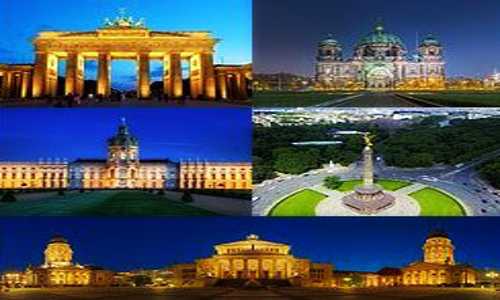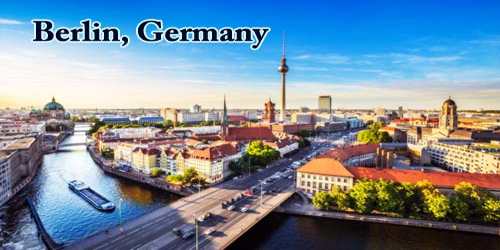Berlin (/bɜːrˈlɪn/; German: bɛʁˈliːn) capital and chief urban center of Germany. The city lies at the heart of the North German Plain, athwart an east-west commercial and geographic axis that helped make it the capital of the kingdom of Prussia and then, from 1871, of a unified Germany. Berlin’s former glory ended in 1945, but the city survived the destruction of World War II. It was rebuilt and came to show amazing economic and cultural growth.
It’s 3,769,495 (2019) inhabitants make it the most populous city proper of the European Union. The city is one of Germany’s 16 federal states. It is surrounded by the state of Brandenburg, and contiguous with Potsdam, Brandenburg’s capital. The two cities are at the center of the Berlin-Brandenburg capital region, which is, with about six million inhabitants and an area of more than 30,000 km2, Germany’s third-largest metropolitan region after the Rhine-Ruhr and Rhine-Main regions.

Founded in the 13th century, Berlin has had an eventful history. Excavations from 2008 suggest that the city maybe even older than was previously assumed: state archaeologists have discovered an oak beam that probably dates back to 1183.
Almost no other metropolis has experienced such frequent, radical change transforming the face of the city. Although Berlin saw steady growth in its importance, dazzling epochs alternated with darker eras. Nevertheless, the formerly divided city has succeeded in becoming a vibrant metropolis in the heart of Europe.
Berlin straddles the banks of the River Spree, which flows into the River Havel (a tributary of the River Elbe) in the western borough of Spandau. Among the city’s main topographical features are the many lakes in the western and southeastern boroughs formed by the Spree, Havel, and Dahme rivers (the largest of which is Lake Müggelsee). Due to its location in the European Plain, Berlin is influenced by a temperate seasonal climate. About one-third of the city’s area is composed of forests, parks, gardens, rivers, canals, and lakes. The city lies in the Central German dialect area, the Berlin dialect being a variant of the Lusatian-New Marchian dialects.
Germany’s division after World War II put Berlin entirely within the territory of the German Democratic Republic (GDR, or East Germany). The city itself echoed the national partition East Berlin being the capital of East Germany and West Berlin a Land (state) of the Federal Republic of Germany (FRG, or West Germany). West Berlin’s isolation was later reinforced by the concrete barrier erected in 1961 and known as the Berlin Wall. Its status as an enclave made Berlin a continuous focus of confrontation between the Eastern and Western powers as well as a symbol of Western lifestyle for 45 years. The fall of the East German communist regime and the accompanying opening of the wall in late 1989 unexpectedly raised the prospect for Berlin’s reinstatement as the all-German capital. That status was restored in 1990 under the terms of the unification treaty, and subsequently, Berlin has designated a state, one of the 16 constituting Germany. These developments heralded the city’s return to its historic position of prominence in European culture and commerce.
Berlin dates its official founding to 1237, the year of the first recorded mention of Cölln. The first documentary reference to Berlin followed in 1244. In 1307 Berlin and Cölln form a union in order to protect and expand their rights against the margrave. Twelve aldermen from Berlin and six from Cölln hold their meetings in the new town hall they share. Each town has its own administration and budget, maintaining internal independence while presenting a united front to the outside world.
In 1360 Berlin-Cölln becomes a member of the Hanseatic League, representing the cities of its region at the League’s meetings in Lübeck. This association of merchants and cities permits the development of wide-ranging trade relations, but Berlin-Cölln carries no great weight in the League. The city gives up its membership in 1518. In 1400 Berlin and Cölln have roughly 8,500 inhabitants and 1,100 buildings. Between them, the twin cities have three town halls, three hospitals, churches, and monasteries with residences for the clergy and the court of the margrave.
The Thirty Years’ War between 1618 and 1648 devastated Berlin. One-third of its houses were damaged or destroyed, and the city lost half of its population. Frederick William, known as the “Great Elector”, who had succeeded his father George William as ruler in 1640, initiated a policy of promoting immigration and religious tolerance. With the Edict of Potsdam in 1685, Frederick William offered asylum to the French Huguenots.
By 1700, approximately 30 percent of Berlin’s residents were French, because of the Huguenot immigration. Many other immigrants came from Bohemia, Poland, and Salzburg.
In 1709 the framework of Greater Berlin was laid when Berlin-Kölln and the newer towns of Friedrichswerder, Dorotheenstadt, and Friedrichstadt were put under a single magistrate. The population grew from 12,000 in 1670 to 61,000 in 1712, including 6,000 French Huguenot refugees.
During the first half of the 18th century, Berlin expanded in all directions. Frederick II the Great adorned the city with new buildings and promoted its economic and infrastructural development. The Napoleonic occupation of 1806–08 caused a serious setback to its development. Part of the administrative, economic, and cultural reconstruction was the foundation, in 1810, of the Frederick William University by the scholar and minister of education Wilhelm von Humboldt. (The university was renamed Humboldt University in 1949.) But colleges and academies had already existed in Berlin since the mid-17th century. Berlin early attracted outstanding thinkers, including the philosophers Georg Wilhelm Friedrich Hegel, Friedrich Schleiermacher, and Karl Marx. The city had its first popular uprising in 1830 when tailors’ apprentices took to the streets over working conditions. The Revolution of 1848 led to a bloody clash between soldiers and citizenry. By this time the city’s population had risen to 415,000, from about 100,000 a century before. With the opening of the Berlin-Potsdam line in 1838, Berlin became the center of an expanding rail network.
The Industrial Revolution transformed Berlin during the 19th century; the city’s economy and population expanded dramatically and it became the main railway hub and economic center of Germany. Additional suburbs soon developed and increased the area and population of Berlin. In 1861, neighboring suburbs including Wedding, Moabit, and several others were incorporated into Berlin. In 1871, Berlin became the capital of the newly founded German Empire. In 1881, it became a city district separate from Brandenburg.
Four times in the 20th century, the date of November 9 has marked dramatic events in the history of Germany and Berlin. On that date in 1918, Berlin became the capital of the first German republic. Five years later Hitler’s putsch was put down in Munich. In 1938 Nazi storm troopers vandalized Jewish synagogues, shops, and other properties in the night of violence known as Kristallnacht (Night of Broken Glass). And on November 9, 1989, East German authorities opened the wall that had divided the city for 28 years. Because of the associations attached to this date, October 3, rather than November 9, became the new national holiday (Unity Day).
Berlin is the most heavily bombed city in history. During World War II, large parts of Berlin were destroyed during 1943–45 Allied air raids and the 1945 Battle of Berlin. The Allies dropped 67,607 tons of bombs on the city, destroying 6,427 acres of the built-up area. Around 125,000 civilians were killed. After the end of the war in Europe in May 1945, Berlin received large numbers of refugees from the Eastern provinces. The victorious powers divided the city into four sectors, analogous to the occupation zones into which Germany was divided. The sectors of the Western Allies (the United States, the United Kingdom, and France) formed West Berlin, while the Soviet sector formed East Berlin.

After the fall of the wall, Berlin has quickly established itself as the cultural center of Europe. Squatters converted abandoned buildings to creative places, the city created more parks and open spaces, and heaps of creative businesses started popping up. Add the low cost of living and a serious amount of history, and visitors have the perfect mix to become the best city in Europe. Over the years, a lot of international creative’s have moved to Berlin and helped to grow the whole scene.
Berlin is a world city of culture, politics, media, and science. Its economy is based on high-tech firms and the service sector, encompassing a diverse range of creative industries, research facilities, media corporations, and convention venues. Berlin serves as a continental hub for air and rail traffic and has a highly complex public transportation network. The metropolis is a popular tourist destination. Significant industries also include IT, pharmaceuticals, biomedical engineering, clean tech, biotechnology, construction, and electronics.
Berlin is home to world-renowned universities such as the Humboldt Universität zu Berlin (HU Berlin), the Technische Universität Berlin (TU Berlin), the Freie Universität Berlin (Free University of Berlin), the Universität der Künste (University of the Arts, UdK) and the Berlin School of Economics and Law. Its Zoological Garden is the most visited zoo in Europe and one of the most popular worldwide. With the world’s oldest large-scale movie studio complex, Berlin is an increasingly popular location for international film productions. The city is well known for its festivals, diverse architecture, nightlife, contemporary arts, and very high quality of living. Since the 2000s Berlin has seen the emergence of a cosmopolitan entrepreneurial scene.
Berlin is situated about 112 miles (180 km) south of the Baltic Sea, 118 miles (190 km) north of the Czech-German border, 110 miles (177 km) east of the former inner-German border, and 55 miles (89 km) west of Poland. It lies in the wide glacial valley of the Spree River, which runs through the center of the city. The mean elevation of Berlin is 115 feet (35 meters) above sea level. The highest point near the center of Berlin is the peak of the Kreuzberg, a hill that rises 218 feet (66 meters) above sea level.
Berlin lies where the influence of the Atlantic Ocean fades and the climate of the continental plain begins. The city’s mean annual temperature is about 48 °F (9 °C), and mean temperatures range from 30 °F (−1 °C) in winter to 65 °F (18 °C) in summer. The average precipitation is 22 inches (568 mm). About one-fifth to one-fourth of the total falls as snow.
Berlin contains three World Heritage Sites: Museum Island; the Palaces and Parks of Potsdam and Berlin; and the Berlin Modernism Housing Estates. Other landmarks include the Brandenburg Gate, the Reichstag building, Potsdamer Platz, the Memorial to the Murdered Jews of Europe, the Berlin Wall Memorial, the East Side Gallery, the Berlin Victory Column, Berlin Cathedral, and the Berlin Television Tower, the tallest structure in Germany. Berlin has numerous museums, galleries, libraries, orchestras, and sporting events. These include the Old National Gallery, the Bode Museum, the Pergamon Museum, the German Historical Museum, the Jewish Museum Berlin, the Natural History Museum, the Humboldt Forum, which is scheduled to open in late 2020, the Berlin State Library, the Berlin Philharmonic, and the Berlin Marathon.
To a large extent, traditional economic activities, greatly reduced by World War II, have been revived throughout Greater Berlin. These include the production of textiles, metals, clothing, porcelain, and china, bicycles, and machinery. Electronics became a principal postwar industry. The production of food, chemicals, cigarettes, and confectionery continues. Berlin is Germany’s largest industrial town and a major center of trade and technological development; many companies maintain facilities in the city. At the end of 2018, the city-state of Berlin had 3.75 million registered inhabitants in an area of 891.1 km2 (344.1 sq mi). The city’s population density was 4,206 inhabitants per km2. Berlin is the most populous city proper in the EU. More than 337,000 families with children under the age of 18 lived in Berlin.
In 2019, Berlin has the best future prospects of all cities in Germany, according to HWWI and Berenberg Bank. According to the 2019 study by Forschungsinstitut Prognos, Berlin was ranked number 92 of all 401 regions in Germany. It is also the best-ranked region in former East Germany after Jena, Dresden, and Potsdam.
Berlin’s role as a city of the imagination, of myth and symbol, reached its zenith not during the years of imperial splendor but during the era that followed, the period of the troubled Weimar Republic in the 1920s, the Goldene Zwanziger Jahre (the “Golden Twenties”), when Berlin developed an extraordinary reputation for cultural brilliance and intellectual ferment. Fritz Lang chose the city of Berlin in which to direct his famous movie Metropolis, and Walter Ruttmann the film Berlin: die Symphonie einer Grossstadt (“Berlin: Symphony of a Metropolis”). The theatres, clubs, cabarets, and other amusement enterprises that made Berlin notorious in the 1920s continued into the postwar period. However, the image of Weimar cultural brilliance, to which many Jewish artists and intellectuals contributed, was succeeded by another image of Berlin as the city of fascist intolerance and genocide, moral breakdown and destruction, until the Nazi regime crashed into defeat. Some of the losses brought by the 12-year Nazi rule can never be entirely restored particularly the cultural contribution of the Jews. But today Berlin again has the largest Jewish community in Germany and a significant number of Jewish institutions, and in 2005 a memorial to Jewish victims of the Holocaust was completed in the city.
Information Sources:
















